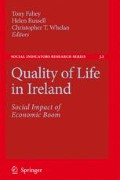One of the common criticisms of the ‘Celtic Tiger’ is that it left the poor further behind: even if they did not become poorer in absolute terms, what they got were mere crumbs compared to the bounty gained by the well-off. Increased marginalisation and social exclusion amid growing affluence has been a recurring theme. One of the problems with this argument is that it has relied, to a substantial extent, on trends in relative income poverty where households are counted as poor if their incomes fall below a certain fixed proportion of mean or median household income, adjusted for family size and composition. However, accurate income data are hard to collect and even when accurate do not always give a good indication of households’ command over resources. Therefore, a picture of poverty based on relative income alone is inadequate. Furthermore, as Chapter 3 has shown, particular difficulties arise in circumstances of exceptional growth, such as have characterised the recent Irish situation, where it is possible for the poor to gain quite substantial increases in income but at the same time continue to be classed as poor in relative income terms.
Our contention in this chapter is that it is possible to categorise the population in this way, though not necessarily in simple dualistic terms – the ‘haves’ and the ‘have nots’. Rather, based on detailed analysis of data for a number of dimensions of living conditions, we propose an 80:10:10 classification. Four out of five of the population can be described as reasonably secure, well-off and insulated from a range of economic stresses and strain to which the remaining one-fifth of the population is vulnerable. This economically vulnerable group can be further divided into two almost equally sized groups. Just less than one in ten of the population simultaneously experience the combination of low income and extreme material deprivation that we refer to as ‘consistent poverty’. A further one in ten, while avoiding such poverty, continue to experience a heightened risk of income poverty, material deprivation and economic stress that marks them off from the more secure four-fifths of the population. Furthermore, we would suggest that among the economically vulnerable there is a smaller sub-set that is multiply deprived in that they are exposed to high risks of deprivation across a wide range of dimensions, including health, housing and quality of neighbourhood.
Access this chapter
Tax calculation will be finalised at checkout
Purchases are for personal use only
Preview
Unable to display preview. Download preview PDF.
Author information
Authors and Affiliations
Editor information
Editors and Affiliations
Rights and permissions
Copyright information
© 2008 Springer Science + Business Media B.V
About this chapter
Cite this chapter
Whelan, C.T., Nolan, B., Maître, B. (2008). Consistent Poverty and Economic Vulnerability. In: Fahey, T., Russell, H., Whelan, C.T. (eds) Quality of Life in Ireland. Social Indicators Research Series, vol 32. Springer, Dordrecht. https://doi.org/10.1007/978-1-4020-6981-9_6
Download citation
DOI: https://doi.org/10.1007/978-1-4020-6981-9_6
Publisher Name: Springer, Dordrecht
Print ISBN: 978-1-4020-6980-2
Online ISBN: 978-1-4020-6981-9
eBook Packages: Humanities, Social Sciences and LawSocial Sciences (R0)

